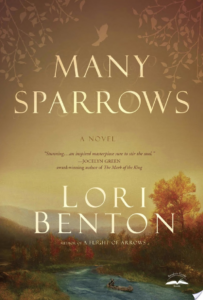 Set in 1774 and based on historical facts, Many Sparrows depicts the harrowing account of a young mother who will stop at nothing to find and reclaim her son after he is taken by a native tribe. Clare Inglesby, a settler of the Ohio-Kentucky frontier, finds herself in a perilous situation when an accident forces her husband to leave her alone on a remote mountain trail with their four-year-old son, Jacob. Her precarious circumstances only intensify when Jacob is taken by the Shawnee under the cover of darkness. Clare awakens the next morning to find herself utterly alone and in labor.
Set in 1774 and based on historical facts, Many Sparrows depicts the harrowing account of a young mother who will stop at nothing to find and reclaim her son after he is taken by a native tribe. Clare Inglesby, a settler of the Ohio-Kentucky frontier, finds herself in a perilous situation when an accident forces her husband to leave her alone on a remote mountain trail with their four-year-old son, Jacob. Her precarious circumstances only intensify when Jacob is taken by the Shawnee under the cover of darkness. Clare awakens the next morning to find herself utterly alone and in labor.
Clare will face the greatest fight of her life as she struggles to reclaim her son from the Shawnee Indians now holding him captive. However, with the battle lines sharply drawn following a conflict between the Shawnee and new settlers, Jacob’s life might not be the only one at stake. Frontiersman and adopted Shawnee Jeremiah Ring comes to Clare’s aid and promises to help her recover her son. However, his deep familial connection to the Shawnee makes his promise more complicated and the consequences more painful than either party could anticipate. Can Jeremiah convince Clare that recovering her son will require the very thing her anguished heart is unwilling to do – be still, wait and let God fight this battle for them?
Benton deftly handles the moral complexity of the two ways of life that clashed against each other as colonists encroached upon Native American territories on the Ohio-Kentucky border. “I was inspired to write it by my research into the 18th century and also by what God’s been doing in my own heart in recent years,” Benton shares. “I hope to convey [in Many Sparrows] a picture of what it means not to rely on our own understanding and strength, but wait on the Lord to work on our behalf.”
 Q: Have you always enjoyed studying history? What drew you to writing specifically about 18th-century America?
Q: Have you always enjoyed studying history? What drew you to writing specifically about 18th-century America?
I had no particular interest in history as a subject until around my sophomore year in high school, when I discovered the Sunfire Young Adult historical romance series (Jessica was my favorite) and Christy by Catherine Marshall. That’s all it took to engage my interest, although it wouldn’t be until I started writing historical fiction I began what I’d call studying history.
What drew me to write about 18th-century America in particular was nothing more profound than a liking for men’s knee breeches. I’d seen the movie The Patriot (starring Mel Gibson and Heath Ledger) and for the first time, for some reason (Mel? Heath?), paid attention to what the guys were wearing. I’d been thinking of trying my hand at historical fiction and suddenly knew that if I did, I’d want my male characters wearing knee breeches. A quick Google search told me the fashion began disappearing around 1800, so I zeroed in on the late 1700s as I began hunting for a time and place to set a story. Little did I know I’d taken the first step on a journey that has lasted nearly two decades. I discovered a passion for 18th-century Colonial and early Federal American history I certainly didn’t see coming when I sat down to watch that movie.
Q: What inspired the storyline for Many Sparrows? How much of the book is based on historical fact?
Story ideas set on the 18th-century frontier are constantly spinning around in my head as I research whatever novel I’m presently writing – too many to write in one lifetime. The initial kernel/idea for Many Sparrows dates too far back to recall it specifically. For years I had a file going called “The Frontiersman” because I knew I wanted to write about one. From time to time other ideas began sticking to the bits in that file, and eventually I saw the beginnings of a story forming about a man who lived his life on both sides of that frontier. I wasn’t really sure yet why. Still on the backburner, I began thinking about what sort of woman I might add to my frontiersman’s story. Why would she be on the frontier? What might compel her to cross the line, and in what way might my frontiersman’s path get tangled up with hers? As I asked such questions, Clare Inglesby eventually formed. At the same time I started looking at what was happening on the frontier at various points before and after the Revolutionary War, seeking the exact year for the story’s setting.
I landed on two incidents that occurred in 1774, one to use as the inciting incident from which the rest of the story flows, and the other much deeper into the story. The Yellow Creek Massacre formed the book’s opening scene. The murder of nearly the entire family of the Mingo warrior, Logan, on the banks of the Ohio happened April 30, 1774. It and his subsequent revenge is part of what escalated the brutal conflict between Native Americans and white settlers along the Ohio that year, culminating in Lord Dunmore’s War and the Battle of Point Pleasant in October. Numerous other incidents portrayed in Many Sparrows are drawn from the historical record, but Logan’s tragedy and Virginia Governor Dunmore’s campaign against the Shawnees are the most prominent.
Q: Can you tell us about the research that went into writing this book?
Like most of my story research, there was a lot of book-reading. My primary source for the historical timeline of 1774 turned out to be a slender volume in the Osprey campaign series, Point Pleasant 1774, by John F. Winkler. Though I spent half my life on the east coast and have nearly 25 years of memories to draw from, I now live 3,000 miles away from the settings of my novels. However, while writing Many Sparrows I was able to take a road trip with a fellow historical fiction author. We covered a lot of ground in Ohio, West Virginia and Pennsylvania, including spending a night in a hotel on the east bank of the Ohio across from Yellow Creek on the spot where Logan’s family was murdered.
Q: There are many things we never learn in history class, and it seems as if students are taught less about history today than ever. What are some lessons from history during this time period that would be beneficial for us to know, especially from a cultural standpoint?
If I could change anything about the way history is taught in school (or was taught when I was coming up), it would be to add historical fiction to the curriculum. Facts, figures, dates – none of that translates to caring about what people in the past experienced or the choices they made that have shaped who we are as a nation. If you can see the past through their eyes – even fictional eyes – it comes alive in a way that actually makes an impact on our thinking (perhaps on our own choices).
What I’ve learned in my study of those who lived in the 18th century is, like us, they were flawed human beings, whatever side of the frontier they happened to be born. Men and women on both sides of the 18th-century frontier made selfless choices, and they made cruel and grasping decisions. Brutality isn’t limited to one skin color or another, and neither is grace and love, forgiveness and friendship, or the capacity to have a heart changed and a life transformed by the indwelling of the Holy Spirit. The Spirit is the only One who can with any finality disrupt the cycle of enmity that has been in play across the face of this earth since Cain turned his hand against Abel.
Q: It is well known that traveling west was a dangerous endeavor, and many lost their lives not only to the elements and illnesses, but to native tribes. What added dangers did a pregnant woman face?
Childbirth was one of the riskiest things a woman in the 18th century could experience. Death in childbirth was common, even in the best of circumstances. Couple that hazard with heading into the wilderness perils you mentioned, and I’m amazed any woman, such as Clare Inglesby in Many Sparrows, survived at all.
In truth, I know of at least one woman in a similar situation to Clare’s who did survive: Mary Draper Ingles. Mary was pregnant when she and her two young sons were taken captive by Shawnees from her frontier home during the 1750s. She went into labor during the long march to the Shawnees’ Ohio villages. She survived childbirth, the march, months of captivity, an epic escape and retracing a journey of hundreds of miles back to her Virginia home. The courage, strength and fortitude women in far less desperate straits than Mary had to possess to venture westward to settle the frontier is astonishing to consider. I’m thankful they did it and I don’t have to.
Learn more about Benton and her books at http://loribenton.blogspot.com. She is also active on Facebook (@AuthorLoriBenton), Twitter (@LLB26) and Instagram (@lorilbenton).

